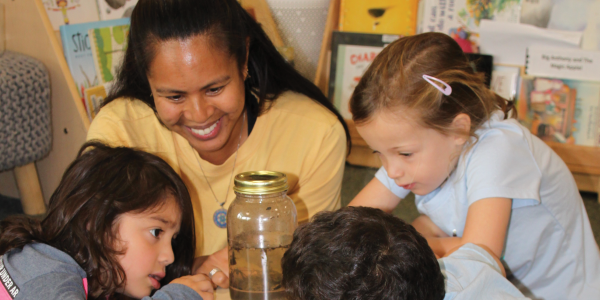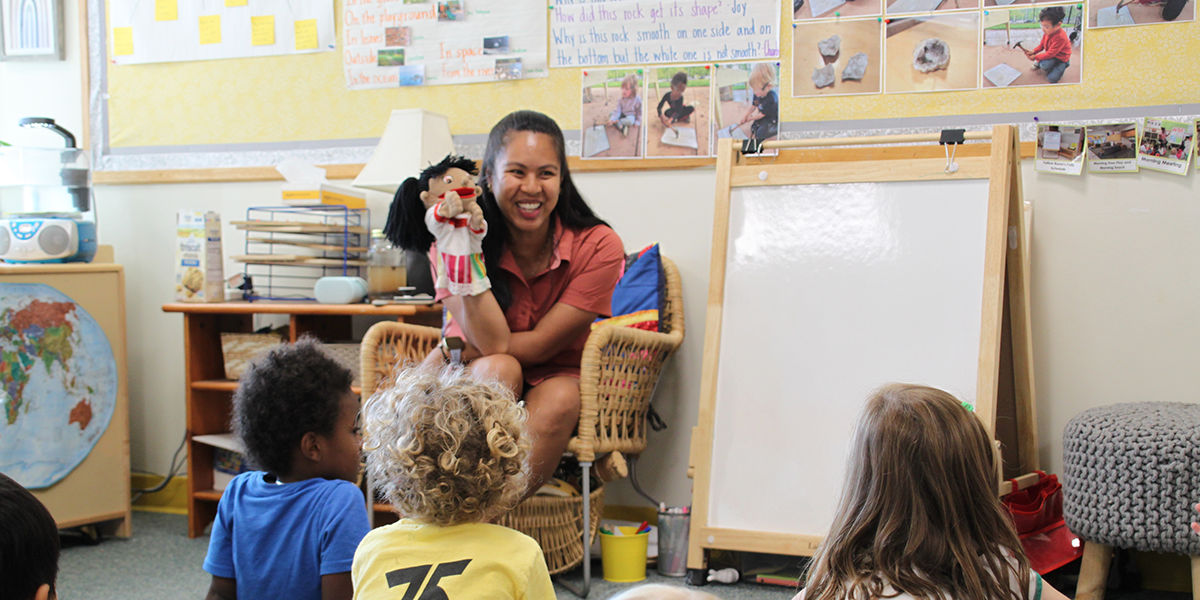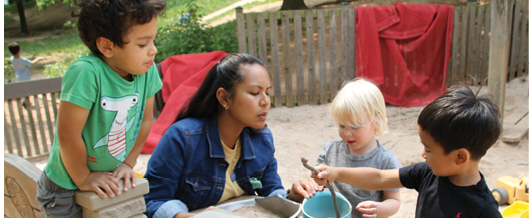Feature Teacher: Cecilia Fowler

You are here
Cecilia Fowler teaches 3- and 4-year-olds at the University of Maryland’s laboratory preschool, The Center for Young Children, where she has been since 2003.
Tell us about yourself!
I received my bachelor of science in early childhood education from the University of Maryland. I am proficient in planning and implementing the project approach. For example, I enjoy creating highly effective and engaging classroom bulletin board displays that challenge children to recall information, question the next steps in their learning, and investigate new information.
Describe the learning setting where you teach.
Our program is located on a college campus, so there's a built-in community aspect. We have access to any expert we could ask for. For instance, when we did a painting study, I went through the undergraduate course list and picked a professor who taught a morning class. I emailed him and asked, “Can my children come and watch your class during a session?” My coteacher and I prepped the children about appropriate touching, talking, asking, and looking at artwork.
As the children walked around, one child noticed a large canvas. The canvas was taller than the college student who had painted it. It was abstract with large brushstrokes. The child told the college student, “It looks like your paint is moving.”
And the college student replied, “It's because I’m a dancer, and I like my paint to look like it's moving and dancing.”
Even though the child was only 3 years old, he picked up on that.

What is something important a child has taught you?
A few years ago, I had a child who seemed to know what to say to get a reaction from me, both positive and negative. I had to teach myself to be calm in my responses. He came to us when he was 3 and was in our class for two years. This was his first experience being at school, and I didn't want his first teacher interaction to be negative. So I focused on his strengths and areas of need. For example, he had lots of ideas and stories to share; he also needed to learn how to have conversations, so I explained, “When you talk, I’ll listen. Then, I’ll respond to what you said, and you’ll listen to me.” Every day I would sit with him at lunch and ask him questions like “What do you have for lunch today?”; “What are you going to do over the weekend?” I wanted to be the teacher he needed me to be. I wanted him to learn that he could count on his future teachers and that they, like me, could appreciate his awesomeness. My job was for him to have an experience that allowed him to love learning, love school, develop positive relationships, and have conversations with others.
What strategies would you recommend to build on children’s individual and family strengths, cultural backgrounds, and experiences and to show children and families that you value them?
I email families at the beginning of the school year and throughout the year, inviting them to come into the classroom to share special and meaningful experiences they have through their culture. I ask them to share and explain their traditions and how they celebrate as a family or community. I also invite family members to be “experts” in our classroom on various topics, such as cooking, baking, gardening, and other talents. I also make sure I have various books and stories in my classroom that represent all the different cultures that make up my classroom.
Please share an example of child-led, project-based learning.
I don't go into projects knowing everything. I learn information when I experience, explore, and research with the children. And that's what I love about the project approach. I encourage the children to think about how we’ll get answers: “How will we solve this problem? You have a question. How can we find the answer to that? Where could we go? Who could we ask? I don't have all the answers; I'm learning just like you.”
This past fall, we went to the campus farmers market because my coteacher and I noticed that the children were interested in pumpkins. The first visit was exploratory—we looked at the different vendors and items. Then we came back with our grocery list and with a parent who oversees the College of Agriculture and Natural Resources’ Terp Farm, who served as our expert.
Visiting the farmers market led to a pumpkin, squash, and gourd study. While we didn’t get firsthand experience growing pumpkins, we did the next best thing—a lot of research. In addition to talking with experts and gathering objects from the farmers market, we referenced books and videos, specifically time-lapse videos.
We also cooked with the produce we bought at the farmers market and saved the rest as frozen puree. None of the parents had tasted the butternut squash soup, pumpkin cookies, muffins, or pumpkin pie we made. The children wondered if we could make those things for our grown-ups, and my coteacher and I said, “Yes, that's a great idea.”
One of the children said, “Let’s have a farmers market.”
It was full circle: We used the farmers market produce to make baked goods that we sold at our own farmers market. Our farmers market was open to the whole campus. We put up signs telling people when and where we were open and the items for sale. On our flyers, we asked people to bring $1 bills because we were also learning about money. In the fall, when we went to the farmers market to purchase our own goods, I converted the $5 bills that families brought into $1 bills. The children would ask vendors, “How much?”, then count out their ones. My coteacher and I knew the same exchange had to happen when the children were sellers.
A lot of work went into this culminating event, which lasted only 45 minutes. It took three weeks to organize. In the process, however, it included lessons on math, social studies, science, literacy, and cooking.
How do you support children at the beginning of the year as they build skills for learning?
September is all about learning classroom routines, how to do project work, and developing relationships. For instance, we talk about what an observational drawing is and how to create one, including what materials are needed. We talk about surveys and who to ask when doing a survey. This helps set the stage for the rest of the year.
How else do you support children as they transition from home to school?
My coteacher and I talk about the social aspects of being in school. We offer scripts for the children, modeling words and actions they can use. We talk about what friendship and kindness are and how the children can ask a classmate to play. We also talk about what happens when they're frustrated with someone else. I have a puppet named Sally, who's 3. In September, I bring her out.
She says, “Mrs. Fowler, I’m nervous.”
I ask her, “Why are you nervous?”
She says, “I’m nervous because I want to play with a friend, but I don’t know how to ask.”
I tell her, “I can help you with that.” I also ask the children to tell Sally what she could say.

What is your favorite children’s book and why?
I tend to gravitate toward folktales and folklore by authors such as Jan Brett and Tomie dePaola. I don’t introduce these books to children in the fall because I have noticed that young 3-year-olds generally don’t seem to engage as fully with slower and longer stories. So we start with books like Mo Willems’s Pigeon series. In the spring, however, the children are usually ready for more. I do the Strega Nona series by Tomie dePaola year after year. The Strega Nona stories are great for focusing on character development: There are a lot of details in them, and the characters are multidimensional. Also, the books in the series build on each other.
This past March, after reading ten Strega Nona books and doing character maps, story mapping, and sequencing, I asked the children what they noticed. Eighteen out of 20 observations were about Big Anthony: “Big Anthony doesn’t listen,” “Big Anthony gets distracted,” “He only says one thing," “He keeps taking Strega Nona’s things." When I called on one of our emergent bilingual learners, he looked at the pictures on the bulletin board and said, "He’s taking the pasta." They all had something to add.
The end goal was to create our own Strega Nona tale. The children were invested in these characters and these stories. When we finished reading them, they knew so much about the characters that they were able to create their own collaborative story to add to the collection.
What are you reading now?
I am reading Quiet, by Susan Cain. I am an introvert by nature with the most extroverted career there is!
How do you take care of yourself?
I love to swim. I swim laps every week, many times a week. Swimming enables me to clear my head and think. I come up with my best classroom and lesson ideas while I swim! I also like to roller skate, but I’m not very good at it!
What is your proudest accomplishment as an educator?
Some of my proudest accomplishments are the smallest. For example, working for half the year with a child to put on their coat independently or having a child make a connection to a book we’re reading and sharing their connection with the whole class.
I knew I had to teach when I went to college and had to really think about who I wanted to be in life. I didn’t grow up wanting to be a teacher. I was one of six, and I helped to take care of my younger siblings. I’ve always been good with children. I enjoy them, talking about them, and being with them.
I keep my passion for teaching alive by discussing different ways to approach a learning activity or study topic. I get excited about sharing the importance of authentic experiences and how to scaffold skills with the preservice teachers I work with. I also talk about the power of observation and asking the children questions. I support children in completing skills independently by sitting near them as they play and work, asking specific questions, and encouraging them to tell me what they’re doing.
What is a future professional goal that you have for yourself?
I would love to present at the NAEYC Conference again! The first time I presented at a NAEYC conference was in 2009. I spoke about a recycling study. The second time I presented was in 2010. My former coteacher and I did a session on the painting study. I enjoy sharing my ideas, knowledge, and teaching techniques with other professionals.
My teaching style involves having free-flowing discussions with the children at meeting time, where they share their ideas and opinions about a topic. Their curiosity and interests guide me. It takes time and practice to get to the point where the children can have these types of conversations, but it’s worth it! It's a little scary when starting out, especially for an organized person who needs to know what’s happening in advance. You have to learn to go with the flow. For example, if my coteacher and I plan two days for a lesson and it takes three, that’s okay because now we know this specific group of children needs three days.
I am a NAEYC member because . . .
I want to be a part of something bigger and greater than my classroom, and I want to share my experience and knowledge about the early childhood field with others.
How has being part of NAEYC positively impacted your teaching and/or interactions with children?
Being part of NAEYC has positively impacted my teaching by encouraging and challenging me to think outside the box and beyond the classroom toward other early childhood educators.
How does advancing equity connect to what you do in your work with young children?
My job as an early childhood educator is to help children embrace themselves and to advocate for their own needs. Because every child is unique, they require different strategies and materials to succeed. For example, in my classroom, we have multiple seating options for the children during meeting time. Most children can sit on the rug “criss-cross applesauce,” but we also provide supports such as a low-backed chair or a wobble disk.
We make various seating options available to all the children throughout the day, but during meeting time, certain seats are reserved for specific children. When a child asks, “Why does he get a chair?” I reply, “It helps him to be a part of our meeting.” We are all members of this class, so I try to instill a sense of belonging and acceptance by providing tools for every child to engage and succeed.
Photos courtesy of Katie McAllister.
Copyright © 2023 by the National Association for the Education of Young Children. See permissions and reprints online at NAEYC.org/resources/permissions.